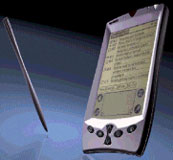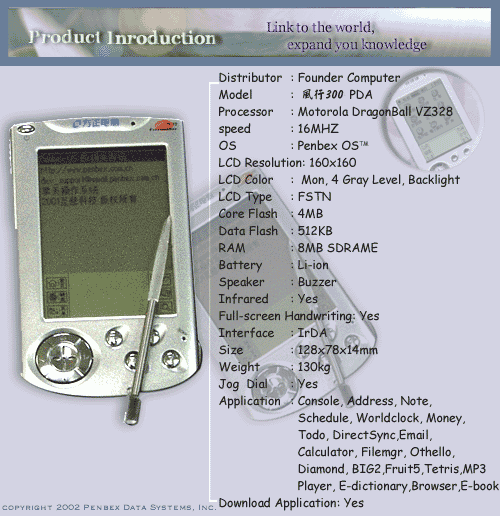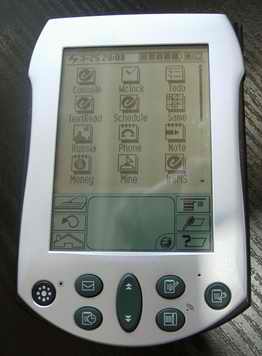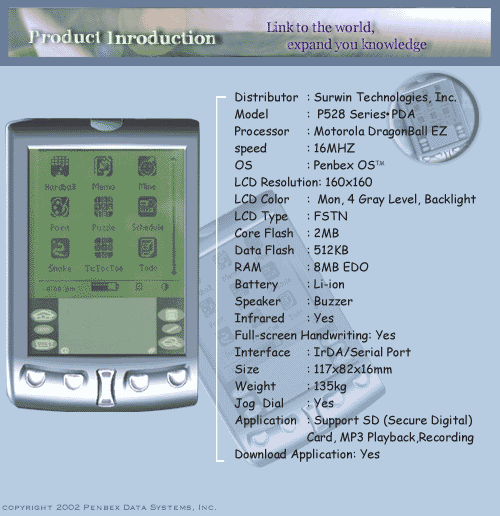The advent of new operating systems - a rare event, even more so. when it comes to operating system for handheld computers. Therefore the news of the release of handheld machines running the original Penbex OS has caused us increased interec. We have long been accustomed to the balance of forces on the PDA market, where the ball is ruled by Microsoft with its Windows CE and Pocket PC and the company Palm. The situation has not changed and with the cessation of production of keyboard Pocket PC Psion, as these machines occupy a niche and compete with besklaviaturny PDA (Psion rooted causes of the failure, most likely in a general decline in demand for small computers with built-in keyboard, and not in some kind of total dominance of the Pocket PC and Palm). As a result, Psion come to grips with software development for mobile communication devices, and the alignment of forces on the PDA market has remained the same as it was - with a small margin of Palm computers, and heightened pressure from the rival platform with the operating system from Microsoft. The main reason for constraining growth in demand for handheld and as a result of technology development - the high cost of small computers for the end user. Handheld computer - a device combining and optional. It can not function without regular synchronization of data between a PDA and a desktop machine (or laptop). This tool, a means of rapid access to stored pre-information off-line image viewer, text and multimedia files and more. Pocket PC, as well as any personal computer can be called "Player Programs". But this PDA software are inferior in terms of functionality, versatility and ease of data processing programs for the "big" cars. In addition, the PDA is not (and still can not be) sufficiently deep and fast means for storing large amounts of information. It is indeed "a computer in the palm" - a miniature digital device for reading and sometimes put in the memory typewriter small amount of data. In principle, without a handheld computer can easily do without. In the end, the possibility of traditional books, paper notepad, electronic calculators and watches are far from exhausted. And here in the foreground price Pocket PC. If entry-level cars were selling for 50-100 dollars (talking about current models, on sales of obsolete machines cost $ 100 and below are not uncommon), would be a long time we reflect on the appropriateness of their purchase? Large print runs of the issue (and, of course, sales), electronic notebooks only support this idea. But the ultimate cost of a pocket computer composed not only of the price of hardware and applications. The lion's share of the cost of the operating system. On the example of the very low-cost PDAs based on Windows CE 3.0 - Casio Pocket Manager BE-300 - we can see that only the manufacturer's refusal of the application of the software package from Microsoft (in the BE-300 used only the core operating system and core applications are developed independently) allowed to market a Pocket PC PDA-class retail value of less than $ 200 ($ 199 in the U.S., Russia, these computers are up to 75 dollars more expensive). That is, savings of at least $ 150. Nearly 80 percent of the final price Casio BE-300! Is this not a reason to actively seek alternative solutions - at least to get the major players in the PDA market to temper their appetites?
What return?
Attempts to develop a new alternative operating system have been made since the advent of handheld computers. The most glaring example - the various versions of Linux, tailored for use on PDAs. Alas, a lot of success so far failed to get anyone, although Japan and the U.S. computers preloaded with Linux operating system sold and used by certain demand (otherwise would not have produced). The reason for the prolonged delivery "of mobile version of Linux is in the system itself. For Pocket PC is too "heavy" and functionality is redundant. In this sense, redundant and Windows CE, but we already know what resources were attracted by Microsoft to promote its product - even after the apparent failure of the first version of Windows CE, and based on its devices.Operating system Windows CE and Linux should be considered as a basis for the Pocket PC-class Hi-end, approaching the cost and performance to a portable personal computers. This is a true multimedia station, pocket-sized, largely designed for entertainment, for playback of digital audio, and viewing of multimedia content - a full-color graphics and video. Most users, polls show, it was necessary electronic notebook with a well-developed service and the ability to transfer to your PDA the data needed in their daily activities. Stop whether simple models of Palm users with monochrome screens, lack of computer resources for high-quality audio reproduction, a modest computational power of the processor or the impossibility of displaying information in color? None. Most owners of these machines is quite happy with their digital assistants, and is not particularly want to change it to a newer model. The principle of reasonable sufficiency, which guides many PDA users the choice of a small computer that is not beneficial to the manufacturer, but by and large - and the consumer. Try to find in the computer world, such longevity as a Palm. But relatively "fresh" model differs from the first m125 Palm Pilot cars are much smaller than, say, computers with Pentium III processors from the Pentium IV. In the first case, productivity growth is negligible, and the capacity of programs, virtually unchanged. In the second case, we can talk about productivity growth at times and qualitatively new opportunities in processing, for example, graphics and video. Whatever it was, but "race frequencies" in the world of handheld computers has begun. So far, only the family Pocket PC, and Palm does not blowjob cup, if the company intends to remain among the world's leading manufacturers. And yet the army of simple computer users with modest computing power is huge (and increasing with the change of generations of handheld computers, as the life cycle of the CPC long-lasting than that of personal computers - at least 3 years, and for the Palm, and even more) to ignore it. Both Asian (mainly Taiwanese) companies are active in this area.
 |
The first noticeable and, judging by the shelves, an unsuccessful project was an operating system for computers called palmopodobnyh MineOS, developed by Axisoft Technologies for the company MSI, which released the Chinese clone of Palm - computer EZnow. This operating system was written in the flash memory machines, and could be optionally replaced by a "native" OS. The program's interface and core application in practical use can be considered more comfortable than the palm `-native. In particular, the window of handwriting information EZnow appeared on a call, as workspace systems Graffiti this computer has been replaced by the SIP application buttons. Some revolutionary differences MineOS of Palm OS could not be found, except that one - an alternative operating system was according to the manufacturer open and completely free. But why - was? Maybe somewhere (in China or other countries), it lives. But we have not developed. And now, at the last exhibition in Hanover, the public was presented the second version of the new operating system from the company Penbex Data System. The first version Penbex OS appeared a year ago. But today the company announced its product as the basis of no less than for even a single hardware platform handhelds. At this time - the most affordable in the history of technology development digital assistants.
Sheep in Sheep's Clothing
Break new platform at a relatively established market (relative to - because handhelds are progressing at breakneck speed), it is almost hopeless.Need some fundamentally new quality, which could distract potential (and actual) users of handheld computers from the now familiar families of Pocket PC and Palm.
Incidentally, the devices based on Penbex OS live not only on paper. They are already available and like to sell. While this is nine models with monochrome screens. But none of these computers apparently not yet reached the foreign markets, and therefore only known Taiwanese user (although it is possible that computers are already available in neighboring countries in the region). The main advantages of the system, designed to "win" the acknowledged leaders, it's complete openness and low cost (explicit indication that the system is completely free, I have not found).
The new operating system puts certain demands on the hardware. Curious to see what it is, the family computer Penbex. Here is a brief list of the technical characteristics of a typical PDA running the new operating system - a device the same as other models, even in minor details. The only difference is in the design of the hull and in the arrangement of control buttons.
 |
Features: - Central Processing Unit - Motorola DragonBall VZ328 such a frequency of 16 MHz
- Touchscreen monochrome 4-level grayscale display and dims. Passive matrix. Screen resolution - 160x160 pixels. Operating System Penbex OS supports the conclusion of the 16-bit color, but devices with a color screen on the market yet.
- The system itself and the main applications are written to flash memory 512 KB (on some models - up to 4 megabytes).
- Memory - 8 MB. Type of Memory - EDO or SDRAM (ie - no flash).
- As a source of supply for all machines (I mean already produced computers) uses built-in lithium ion battery. Voltage - 3 B.
- All computers are equipped with an infrared port (the operating system supports far only the wireless exchange of data between two PDAs, but not connected to a laptop or a desktop machine), a piezoelectric buzzer as the system dynamics, exit to stereotelefony (MP3 player is implemented in hardware, software and audio included in the composition of the main applications in the operating system)
- To synchronize with your desktop computer using a serial port RS-232C, USB support is missing.
- As an expansion slot is used CompactFlash. However, the operating system, except cards CF, supports a standard MMC card and SD.
- Dimensions and weight characteristics of new computers in general coincide with similar computers family Palm.
Programmers are likely to be interested in the fact that Penbex offers everyone a free SDK with emulator software for Windows. In this operating system provided file system support FAT16, support at the system level of work in dBase3, API-function calls, MP3-player and library work with SD-card support for color displays (Penbex version 2.x). What good, then - well. Development tools integrated with Visual Studio 6.0, which certainly is convenient for programmers who are accustomed to this IDE.
What's on the horizon?
How much do you think the chances of this Penbex grab their piece of the total market pie? It seems to me - quite a bit. Operating system interface quite crude.More on-screen buttons next to the area handwriting (six instead of four in Palm). Slightly differently drawn icons of programs ... The screen is not impressive at all, not to say that is depressing ... From time to time the market appears cheap computers with unique operating systems. They are slightly below the level for Palm, but not too much of them behind. Example - Pocket PC Pocket Viewer from Casio, which are heavily advertised in Russia. Like it is a good machine (on the quality of the screen, if only to read books, work with spreadsheets and playing simple games, they are perhaps better than monochrome Palm `s, although it does not support greyscale), but something about her all the same lacking. Namely - the popularity. As a result, software written by amateurs or those computers, or by the manufacturer. The total number of programs for the Casio PV will be hardly one hundredth of the total number of applications for Palm. And maybe less. No, I saw a hand-held computers Penbex any advantage over the machine from Palm. Moreover, the position Penbex worse than that computers with the operating system EZnow Mine OS. There's a unique change the operating system on the Palm OS - a pushover (as when buying a computer only pay for the hardware if the OS is indeed free of charge). Get it with a computer-based Penbex OS? There is quite a different logic implementation of the management of hardware buttons (in this part of the CCP Penbex resemble an amazing hybrid computers, Palm and Pocket PC). In my opinion, Penbex and companies who make a bet on this operating system, there is only one way to succeed - to release a massive model of Pocket PC to an extremely low price. Nothing other than cost, the new platform is not able to attract. This, alas, yesterday ... However, speculate about hypothetical delights and drawbacks - it stupid and useless. Wait and see. Perhaps the developers udast'sya bring it to an acceptable level and make the CCP property of the broad masses. In any case, the company Penbex Data System should say thank you for some variety, it has introduced a Pocket PC user. Or hope for this variety. The authors, translation:



